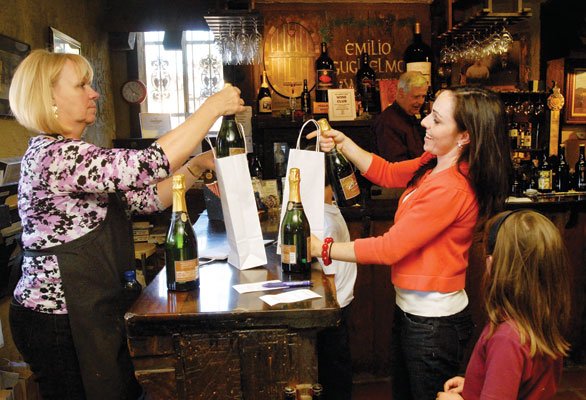Despite economic downturns, wine sales remain steady, if not
growing. Wine enthusiasts seeking out lesser-known varietals,
heightened media exposure to wine and wine-friendly dining, people
sneaking in a bit of luxury to their otherwise tight budgets, a
recent court ruling allowing more direct-to-consumer sales
– all of these factors make for a healthy wine industry in the
Santa Clara Valley and California in general, say area wine
insiders.
Despite economic downturns, wine sales remain steady, if not growing. Wine enthusiasts seeking out lesser-known varietals, heightened media exposure to wine and wine-friendly dining, people sneaking in a bit of luxury to their otherwise tight budgets, a recent court ruling allowing more direct-to-consumer sales – all of these factors make for a healthy wine industry in the Santa Clara Valley and California in general, say area wine insiders.
And, despite economic downturns elsewhere, the wine industry shows no signs of slowing as “foodies” embrace wine as their preferred beverage accompaniment with gourmet-style meals.
Americans drank 745 million gallons of wine, spending $30 billion. California slurped up most of the profit, having shipped 456.7 million gallons of the beverage to other states.
Shipments of California-produced wine have grown steadily in the past few years, thanks in part to a Supreme Court ruling allowing 11 more states to accept out-of-state direct wine sales.
“We’ve gotten to the point now where approximately 80 percent of the U.S. population lives in a state where a California winery can mail,” Wine Institute Director of State Relations Steve Gross said. He said the industry has come a long way since 1985, when no states allowed out-of-state direct wine sales.
Winery owners Teri Fortino and Al De Rose speculate that Food Network programming feeds viewers a diet with Mediterranean flavors, doused in balsamic vinegar and boutique olive oil aplenty.
“As the Mediterranean lifestyle trend influences our society, we see more (people) drinking (wine) on a regular basis,” said Fortino, an owner of Fortino Winery, a Gilroy boutique- to medium-size winery specializing in Italian-style reds.
The Mediterranean diet generally mirrors the food pyramid, with lots of fruits and vegetables, a hearty serving of bread, some cheese and meat, small amounts of fat – and lots of wine.
The natural marriage of food and wine has boosted business at Hollister’s Pietra Santa Winery, too, said Jayme Nunn, director of marketing at the 50,000-case per year winery.
“There’s so much romance around wine and people who enjoy food enjoy wine too,” she said. “It’s fun to explore, because each wine has a different flavor profile.”
Gourmet food enthusiasts who delve into wine will find endless opportunities to try new tastes for their ever-changing palette, Fortino said.
“Wine is very trendy, it goes through different phases,” she said. In recent years, White Zinfandel had its place, she said. The fruity white wine, which peaked in popularity from about 1995 to 2000, introduced a lot of people to wine in general.
The woodsy red Pinot Noir stood in the spotlight for the next five years; and now, another white wine has stepped up to shine, Pinot Grigio.
Gene Guglielmo, co-owner of Guglielmo Emilio Winery, a third-generation winery in Morgan Hill that produces 120,000 cases of wine per year, said there have been about 10 percent more people in area tasting rooms. He sees no slowing in wine’s popularity.
“People are drinking more wine due to the health aspect,” he said. Guglielmo named the Mediterranean diet as healthier than the traditional American high-fat, low-wine diet.
Al De Rose, co-owner of De Rose Vineyards in Hollister, credits another diet with helping increase wine’s notoriety – the “low-carb” diet trend.
“People are getting away from beer and mixed drinks,” he said, citing their high-carbohydrate content.
These food trends lend themselves to a long-term trend of increasing California wine sales, according to data compiled by California’s Wine Institute.
A total of 457 million gallons of wine were sold in 2007, a record high and 2 percent more than in 2006. California sales have grown for 14 consecutive years, increasing 66 percent by volume from 1993 to 2007.
Another contributing factor to high wine sales is the 2005 Supreme Court ruling on direct-to-consumer shipping. Direct sales refer to any sort of winery-to-consumer sale, including tasting room, wine club membership, catalog and Web site sales.
Alex Larson, co-owner of Rapazzini Winery in Gilroy, said the recent direct-sales ruling on direct sales hasn’t skyrocketed sales, but might have dodged another bullet – recent airport regulations banning carry-on liquids.
Before, tourists were used to buying souvenir wine and carrying it on the plane with them. Stricter airport regulations mean these tourists would have to be pack their souvenirs with checked luggage instead. Rather than dealing with the hassles involved with paying for over-weight luggage or bottles breaking in transit, Larson said his winery advises shipping it to themselves first – an option for more tourists thanks to the ruling.
Pietra Santa Winery’s wine club has more room for growth, thanks to the ruling. The club boasts 850 members, about 40 percent of which are from outside California. Wine club membership grows about 30 percent each year, said Nunn.
“We continue to get more and more people from further away,” she said. “A lot are coastal drivers, visiting Monterey and Carmel.”
Adventurous wine drinkers are a boon to the Central Coast wine-growing region, which produces wines with concentrated flavors, Nunn said. The minerals in the soil, thanks to San Andreas Fault, produce hints of eucalyptus, licorice and spice. Rocky soils mean vineyards have to work harder, and because of this, produce low yields but with a concentrated flavor, she said.
Winery owners, along with Gross, speculate that extensive media coverage, like wine columnists in newspapers and wine reviews in magazines, has made consumers more adventurous, especially in the younger crowds that have trickled into tasting rooms of late.
“They’re more adventurous about trying an Argentinian or Chilean wine – if it’s $15,” De Rose said of this younger crowd.
Other than the money-conscious 20-somethings, the state of the economy doesn’t phase the wine industry, and some industry insiders like Larson say it just might help.
“Whenever the economy is down, we find that more people are staying at home and want to give themselves a little bit of luxury,” Larson said. “Part of that illusion of luxury is to have a bottle of wine with their meal.”
Instead of going out and spending $100 or $150 on a dine-out meal, families have a nice dinner at home instead, he said. And they still save money, even if they buy a $20 bottle of wine to accompany the home-cooked meal.
“It feels like they’re still giving themselves a treat,” he said.














